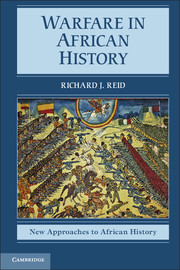Book contents
- Frontmatter
- Contents
- Maps
- Preface
- Acknowledgements
- List of maps
- Chapter 1 The Contours of Violence
- Chapter 2 Arms in Africa’s Antiquity
- Chapter 3 The Military Foundations of State and Society, to circa 1600
- Chapter 4 Destruction and Construction, circa 1600 to circa 1800
- Chapter 5 Transformations in Violence
- Chapter 6 Revolutions Incomplete
- Index
- References
Chapter 3 - The Military Foundations of State and Society, to circa 1600
Published online by Cambridge University Press: 05 June 2012
- Frontmatter
- Contents
- Maps
- Preface
- Acknowledgements
- List of maps
- Chapter 1 The Contours of Violence
- Chapter 2 Arms in Africa’s Antiquity
- Chapter 3 The Military Foundations of State and Society, to circa 1600
- Chapter 4 Destruction and Construction, circa 1600 to circa 1800
- Chapter 5 Transformations in Violence
- Chapter 6 Revolutions Incomplete
- Index
- References
Summary
The era between the early second millennium and circa 1600 is significant as a discrete unit of study owing to several key developments. The era of the great cavalry empires in the western and central savannah reached its apex in Mali and Songhay, but by the beginning of the seventeenth century, alternative frameworks for military activity would emerge, moving away from the empire-state model which had dominated the region for so long. Another military state with its roots in antiquity, Solomonic Ethiopia, would likewise achieve remarkable success in the fourteenth and fifteenth centuries, before a series of wars in the sixteenth brought it to the point of extinction. Unlike its West African counterparts, however, Ethiopia would survive – just. Further south, the foundations built in the first millennium, particularly in the wake of the Bantu diffusion and attendant political and economic transformation, would be used to create some of the most dynamic military organisations on the continent by the end of the sixteenth century, if frequently more compact and less concerned with the overt control of territory than some of their counterparts north of the forest zone. A series of state and non-state structures emerged across sub-Saharan Africa, each in different ways placing war at the centre of policy and culture. Some of these would prove remarkably durable. Once again, as in earlier centuries, migratory movements proved seminal. If the Bantu expansion and Arab migrations had been among the crucial dynamics of antiquity, in the first half of the second millennium there were population movements of no less import, if on a somewhat smaller scale: The Nilotic migrations into lacustrine eastern Africa and the Oromo expansion into the Ethiopian Highlands in particular revolutionised the nature of warfare and military organisation in their respective arenas, and transformed forever the polity itself.
- Type
- Chapter
- Information
- Warfare in African History , pp. 46 - 78Publisher: Cambridge University PressPrint publication year: 2012



